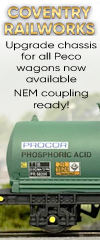- Welcome to N Gauge Forum.
A Coarse Guide to the Steam Locomotive for ‘N’ Gauge ModellersStarted by Train Waiting, December 08, 2023, 09:15:27 AM Previous topic - Next topic0 Members and 7 Guests are viewing this topic.
User actions
| Please Support Us!
July Goal:
£100.00 Due Date: Jul 31 Total Receipts: £43.45 Below Goal: £56.55 Site Currency: GBP 43% July Donations |








